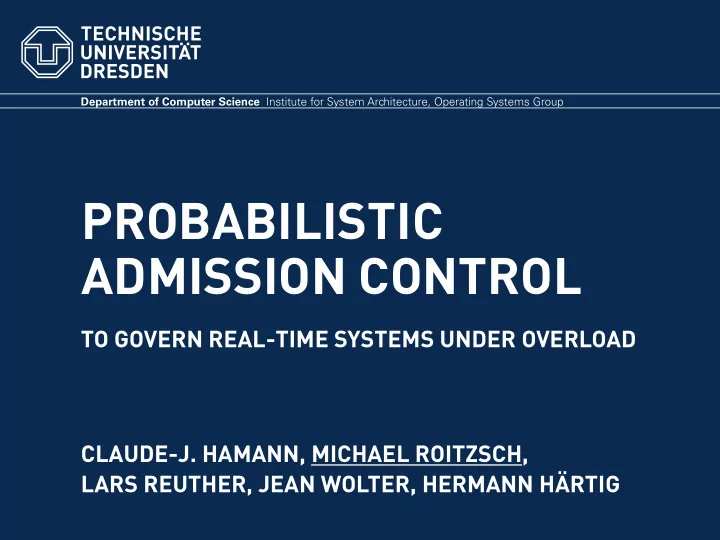

Department of Computer Science Institute for System Architecture, Operating Systems Group PROBABILISTIC ADMISSION CONTROL TO GOVERN REAL-TIME SYSTEMS UNDER OVERLOAD CLAUDE-J. HAMANN, MICHAEL ROITZSCH, LARS REUTHER, JEAN WOLTER, HERMANN HÄRTIG
MOTIVATION ■ desktop real - time ■ there are no hard real - time applications on desktops ■ there is a lot of firm and soft real - time ■ low - latency audio processing ■ smooth video playback ■ desktop effects ■ user interface responsiveness
H.264 DECODING 15% 10% 5% WCET 0% 0 5 10 15 20 25 30 ms
H.264 DECODING 15% 10% Requirements even slightly below 100% can dramatically reduce resource allocation. 5% WCET 0% 0 5 10 15 20 25 30 ms
SRMS ■ Statistical Rate Monotonic Scheduling ■ local admission ensures percentage of successful jobs ■ execution time of each job must be known in advance
PROBLEMS ■ WCET largely exceeds average case ■ poor utilization efficiency ■ restricted to specific task types ■ tough runtime requirements ■ missed deadlines can at best be predicted
DESIGN GOALS ■ use distribution instead of WCET ■ relax guarantees, improve utilization ■ hard, firm, preemptible, non - preemptible ■ minimal runtime dispatcher requirements ■ controllable fraction of missed deadlines
KEY IDEA Use probabilistic admission control to model the actual run - time dispatching.
KEY IDEA WCET
KEY IDEA WCET
RESERVATION J r J P ( J does not run longer than r ∧ J is completed until its relative deadline ) ≥ q
TASK MODEL ■ tasks T i are sequences of periodic jobs ■ period length = relative deadline d i ■ jobs are partitioned into one mandatory part and m i optional parts ■ mandatory part‘s execution time X i with WCET w i ■ optional part‘s execution time Y i ■ quality q i : fraction of completed optional parts
ADMISSION GOAL priorities and reservation times for all jobs to generate a feasible schedule ■ all mandatory parts meet their deadlines ■ all optional parts meet their requested qualities
QAS ■ Quality - Assuring Scheduling (RTSS‘01) ■ priority assignment: ■ all mandatory parts first ■ higher quality → higher priority ■ reservation times: p i ( r ) = P ( Y i ≤ r ∧ n i − 1 � � X i + min( Y j , r j ) + Y i ≤ d ) i =1 j =1 � �� �
EXAMPLE 3 Tasks: 1 mandatory, 1 optional part each d X 1 X 2 X 3 Y 1 Y 2 Y 3 p i ( r ) = P ( Y i ≤ r ∧ n i − 1 � � X i + min( Y j , r j ) + Y i ≤ d ) i =1 j =1 � �� �
DOWNSIDE ■ expensive computation for arbitrary periods ■ hyperperiod explodes for task sets with close - by period lengths (LCM of 503 and 510 anyone?) ■ new algorithm differs in three ways ■ priority assignment ■ notion of reservation time ■ very low - cost admission
QRMS ■ Quality - Rate - Monotonic Scheduling ■ cut down the exact modeling of dispatcher behavior in favor of a simpler algorithm: ■ priorities are assigned to tasks as in RMS ■ combined reservation for all parts of a job ■ reservation time regarded constant execution time in the admission ■ tasks are independent for admission
EXAMPLE QAS: X 1 X 2 Y 1 Y 2 QRMS: X 1 Y 1 X 2 Y 2
RESERVATION m i i = min( r ∈ R | 1 � r ′ P ( X i + k · Y i ≤ r ) ≥ q i ) m i k =1 r i = max( r ′ i , w i ) i = 1 , . . . , n ■ Where is the deadline? ■ consider reservation as constant execution time of a rate monotonic task ■ use any RMS admission criterion ■ aborting by deadline does not happen
COST ■ Admission ■ computational cost dominated by convolutions ■ O( number optional parts × ( number of bins in distribution ) 2 ) ■ 5ms per part for hundreds of bins ■ Runtime ■ static priorities
ACCURACY Mandatory Optional Requested Achieved Period Part Part Quality Quality 70% 70.23% 20 N(5,1), w=6.5 N(3,1) 90% 89.72% 30 E(0.33), w=4 N(2,3) 80% 78.44% 50 E(0.25), w=2 N(5,19.5)
QRMS VS. SRMS Mandatory Optional Requested QRMS SRMS Period Part Part Quality Quality Quality 70% 70.06% 85.9% 10 N(2,0.5), w=3 N(1.5,0.5) 50% 99.95% 77 .5% 20 E(0.33), w=6 N(2,1) 75% 74.76% 79.3% 60 N(6,3), w=10 E(10) r i = max( r ′ i , w i ) i = 1 , . . . , n
QRMS VS. QAS ■ performed simulations: random qualities, random distributions QAS QRMS uniform, optional only ++ + uniform ++ harmonic ■ yet to come: quantitative analysis, utilization discussion, application studies
CONCLUSION ■ handles arbitrary, empiric distributions ■ high utilization by probabilistic guarantees ■ mandatory and optional parts, subjobs ■ static priority dispatching ■ intuitive quality parameter
Recommend
More recommend